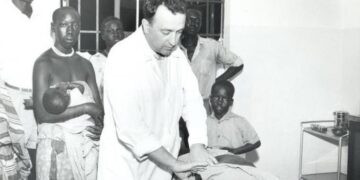Brother Robert Macke, known to many of his colleagues as “Brother Bob,” is a Jesuit astronomer at the Vatican Observatory and one of the world’s foremost experts in the study of meteorites. So, when Dr. Andy Ryan, one of the leads for NASA’s OSIRIS-REx mission, needed help constructing a device to study some of the oldest asteroid material in the solar system, he naturally turned to Macke.
The NASA mission required a custom-built “pycnometer” to measure the density and porosity of asteroid material taken from deep space. The device had to fit very specific restrictions to avoid contaminating the samples. Companies selling off-the-shelf pycnometers didn’t fit NASA’s specifications — only Macke was able to make the exact device the OSIRIS-REx mission needed.
Now, Macke’s device will be used to closely study the asteroid material and hopefully answer some of NASA’s biggest questions about the origins of the solar system.
What is the OSIRIS-REx mission?
OSIRIS-REx, which is short for the “Origins, Spectral Interpretation, Resource Identification, Security-Regolith Explorer,” is the first U.S. mission in history to deliver asteroid samples to Earth.
After seven years in space and collecting 8.8 ounces of surface material from the asteroid “Bennu” 200 million miles away, the OSIRIS-REx spacecraft landed back on Earth on Sunday, Sept. 24.
The samples, which NASA says date back to the earliest days of the solar system, were taken to NASA’s Johnson Space Center in Houston, where they will be permanently housed and studied.
NASA believes the sample taken by OSIRIS-REx will help answer questions about both the nature of asteroids and the origins of life in the solar system.
According to the NASA project’s website, the Bennu asteroid “is a remnant from the tumultuous formation of the solar system” and unlike any rocks found on Earth, “Bennu’s rocks offer us insight into our own history — a time about 4.5 billion years ago when Earth was first forming.”
How a religious brother helped NASA
According to Macke, Ryan wasn’t originally intending to ask him to join the mission, but after they began to talk, he realized Macke was the perfect candidate to lead the construction of the pycnometer.
“He contacted me because I have extensive experience with the measurement techniques involved, having applied them to a few thousand meteorites and other specimens from collections in several cities in the USA and elsewhere,” Macke told CNA. “At first he was just looking for advice, but as we talked more about it, eventually he asked me to join the team and to direct the construction of the device.”
According to Macke, the process of constructing the device took over two years. His team’s efforts were complicated by the fact that the pycnometer had to be completely free of anything that might contaminate the specimens.
Now that the asteroid sample has returned to Earth, Macke’s pycnometer will be a crucial tool to unlock the secrets being held by Bennu hundreds of millions of miles away.
“We have successfully built the device, but my task is not finished,” Macke said. “The next step is to use the device to measure the densities of these specimens. This process will be spread over several weeks, and perhaps months. I cannot declare complete success for my part of the project until it is finished.”
The study begins
Macke will be helping study the samples in Houston when it comes time to use his device.
“The OSIRIS-REx mission is a massive collaboration of scientists and engineers spanning numerous institutions and several countries,” Macke told CNA. “It is a real honor to be included among their number.”
Macke noted that he is “particularly excited” to be “helping to contribute to the wealth of knowledge that we will develop from the specimens brought back to the Earth from the asteroid Bennu.”
















